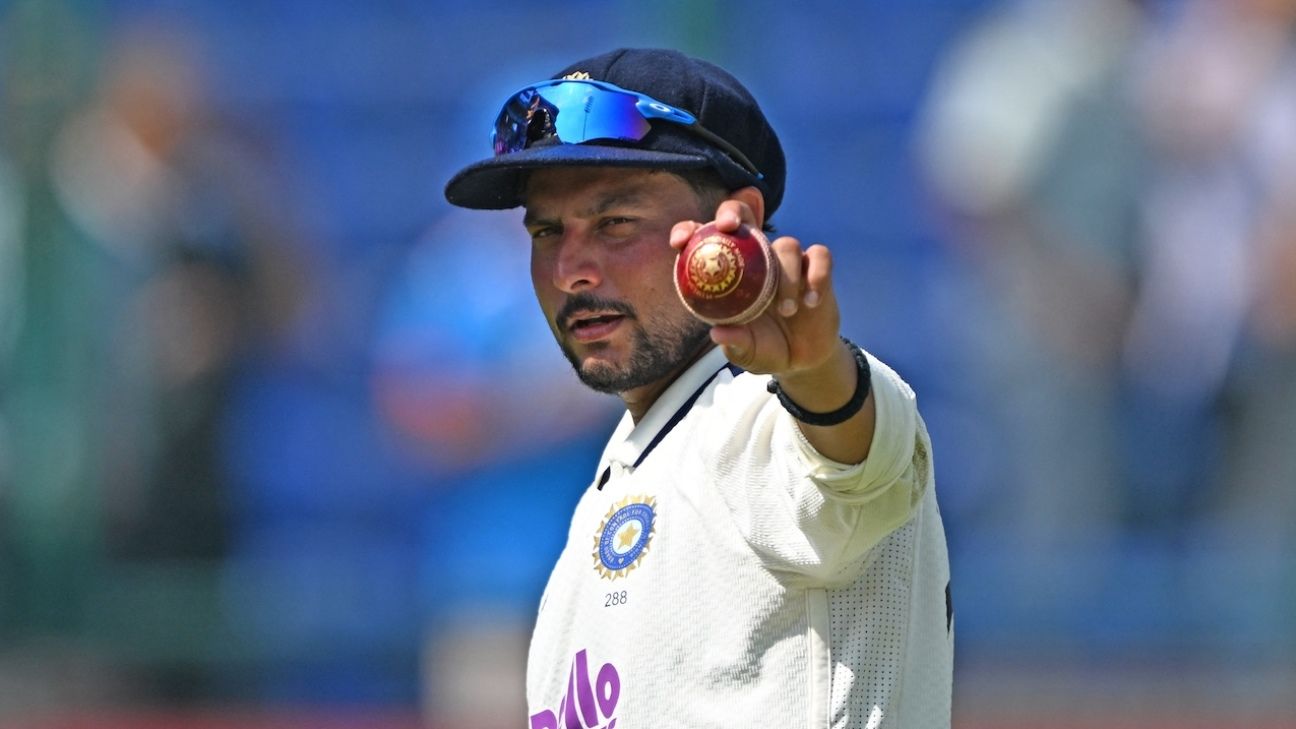Kuldeep Yadav has won three Player of the Match awards in Test cricket: against Bangladesh in Chattogram in 2022, against England in Dharamsala last year, and in India’s last Test match, against the West Indies in Delhi last month.
On the first two occasions, India left Kuldeep out of the playing XI for the next Test. On both occasions – Mirpur 2022 and Chennai 2024 – he was out because India left spinners to field an extra seamer.
There is now a chance that Kuldeep’s bad luck with the man-of-the-match awards will continue until Friday, as India captain Shubman Gill suggested on the eve of the first Test against South Africa that the team management was discussing the choice between an extra all-rounder and an extra spinner.
The context for Gill’s statement was a question on whether India were considering opting for a third seamer rather than a third spinner given Eden Gardens’ recent history of supporting fast bowling.
This was Gill’s response: “At this time of year, there’s always a struggle as to whether you want to go with that extra all-rounder or you want to go with that extra all-rounder, but once we come tomorrow and see what the wicket looks like in the morning, we’ll make a decision (on) what kind of combination will give us the best chance of being able to win this Test match.”
The Indian bowling line-up in their last Test match in Delhi consisted of two seamers in Jasprit Bumrah and Mohammed Siraj and three spinners in Kuldeep, Ravindra Jadeja and Washington Sundar, the last two of whom are all-rounders.
There are two possible interpretations of Gill’s statement.
The first is that India are considering selecting a third seamer, in which case Akash Deb will come into their attack. This then means excluding Washington or Kuldeep.
Given that Gill referred to this time of the year, this seems to be a potential pitfall for India. The weather in Kolkata during the Test match is set to be mild, with daytime temperatures in the mid to early 20s (C). With the ground crew preparing a pitch that looks like it will start out flat and true, there’s a chance the sun won’t hit hard enough during the first two or three days to accelerate surface erosion. With swing, both traditional and reverse, likely to play a role during the Test match, India may feel that the third seamer could be a more likely wicket-taking option than the third spinner.
This would leave them in a classic debate: attacking a wrist-spinner with the tools to take wickets even on flat pitches (Kuldeep) versus an all-rounder who is good at playing either as a pure batsman or bowler in Indian conditions, but is unlikely to run through teams on unhelpful surfaces (Washington).
On the evidence of the Delhi Test, where India spent 200 successive overs on the field after following West Indies, India are heavily tipped to opt for Kuldeep. On Delhi’s slow, low pitch where edges were rarely carried to close catchers, Kuldeep was India’s most consistent bowler, taking 8 for 186 in 55.5 overs. Between them, Jadeja and Washington bowled 88 overs and took 5 for 269.
But India values batting depth, and has emphasized it to an unusual degree during Gautam Gambhir’s tenure as head coach. Kuldeep can finally hold his own as a lower-order batsman, as he has shown previously in Test cricket, and demonstrated last week when he scored 20 off 88 balls and 16 off 54 in India A’s second unofficial Test against South Africa A in Bengaluru. But Washington is a decent batsman with a century, five fifties and an average of 44.76 in Tests. There is no competition between the two as hitters.
Even if he lacks Kuldeep’s wicket-taking genius, Washington is a true bowler in home conditions, and can bowl long overs and test the batsmen’s defense even on flat pitches, particularly through his ability to generate extraordinary amounts of drift.
It’s not a straightforward choice at all, if the choice is between Kuldeep and Washington, with the player opting to bat at number 8.
Another possible explanation for Gill’s words, though, is that India are sticking with a line-up of two seamers and three spinners, with Kuldeep and Axar Patel – who will be the third extra – competing for one place.
In the press conference on Thursday, Gill was asked if it was the conflict between Kuldeep and Axar that he was referring to.
“I think we’ll leave that for tomorrow,” Gil said after a while of silence. “You can see it when you ejaculate.”
In most circumstances, three all-out bowling would seem like overkill, an over-the-top defensive move, especially if it comes at the expense of the point of difference that Kuldeep brings to India’s attack. With Rishabh Pant returning to the XI and Nitish Kumar Reddy being displaced, their batting certainly does not need the extra security that Axar provides at number nine.
But there are signs that India might be a bit worried about Kuldeep’s form. They released him in the middle of the white-ball tour of Australia so that he could get into the red-ball rhythm by playing an unofficial Test for India A. And he continued to endure a difficult match with the ball: just one wicket across two innings in South Africa A’s five-wicket win while running the ball in the first innings and at nearly five more in the second.
Anyone can have a bad game, of course, and Mohammed Siraj and Akash Deb, who also played that match, also bowled expensive spells, on a pitch at the Center of Excellence in Bengaluru, which started out as a green seamer before turning completely flat.
But Siraj and Akash Deb are not in the position that Kuldeep held during his career. Be it Jadeja, R Ashwin in his early years or Jadeja, Washington and Axar now, he has always been the wrist spinner who doesn’t compete much with all the quality finger spinners. Any fluctuation in Kuldeep’s form is an opportunity for one of the others to remind the team management of their best qualities.
And Kuldeep doesn’t compete with all-round bits and pieces. Even Axar, who has not played a Test match since February 2024, is a true bowler in Indian conditions. When he lost his place during the series against England last year, he was starting to look a little one-dimensional, threatening only one edge of the bat, and teams appear to have overcome the threat of releasing him wide and undermining him. But he has shown signs of late, albeit in white-ball cricket, where he has worked hard on adding more layers to his skill, bowling a noticeably higher percentage of heavy balls in the 81-84kmph range, which is much slower than his usual pace.
As there is stiff competition, none of the spinners in India stands still and relies on their skills. They simply cannot afford it.
“I consider myself very fortunate to have all the players we have,” Gill said. “Be it Axar Patel, Washington or Jadu BhaiWhether it’s their bowling record or their batting record, it’s really good, especially in India. As a captain, it is very difficult to decide who to pick and who to leave out, because they are good batsmen as well as bowlers, they are proper fielders (…) but it is better to have too many options than too few options.
Once again, the problem of abundance in India made them think about the headache of division of choice. Whether it is two spinners or three, whether it is two all-rounders or three, the one who would field most other Test teams will sit out.













